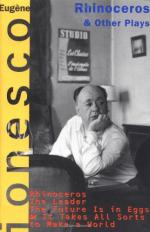|
This section contains 768 words (approx. 3 pages at 300 words per page) |

|
[Rhinocéros is not an allegory.] Few readers are likely to agree at the outset with this assertion, because for most interpreters of the play, starting with its author, Eugène Ionesco, Rhinocéros is indeed allegorical—or at least broadly symbolic. The meaning of the drama must be explained in dualistic terms, so the argument goes: good versus evil, Bérenger against the world, humanity refusing to succumb to the grotesque epidemic of rhinoceritis, the individual—flawed but admirably courageous—celebrating selfhood in defiance of conformism or totalitarianism, language holding its own in the face of rampant noncommunication. (p. 207)
If we disregard external evidence …, we discover that the thematic import of Rhinocéros is less transparent than has often been contended. Having stripped away all elements foreign to the text, one must attempt to answer some fundamental questions about the nature of literature in general and about...
|
This section contains 768 words (approx. 3 pages at 300 words per page) |

|


